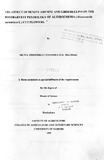The effect of benzyladenine and gibberellins on the postharvest physiology of alstroemeria (alstroemeria aurantiaca l.) cut flowers.

View/
Date
1999Author
Mutui, Theophilus M
Type
ThesisLanguage
enMetadata
Show full item recordAbstract
The objective of this study was to investigate the response to exogenous BA (Accel) and
gibberellins (GAm) on the vase life and the physiological changes in the leaves of Alstroemeria
cut flowers. Florissant 200 and 2.0 mM STS (commercial flower preservative solutions) were
used as a reference for the best postharvest treatment of Alstroemeria cut flowers in order to
broaden the applicability of the results to the floriculture industry. The treatments were
combined in a factorial manner and laid down in a completely radomised design.
Treatment of Alstroemeria cut flowers with 25 or 50 mg/litre BA equivalent (Accel) consistently
increased the number of days to full opening of primary florets and delayed the onset of flower
senescence as measured by days to 50 % petal fall and 50 % leaf yellowing. Accel (25 mg/litre
BA) increased the leaf nitrogen content, chlorophyll and water content of the Alstroemeria cut
flowers compared to the control. However, Accel (100 mg/litre BA) gave the highest values of
dry weight and leaf nitrogen content.
The lower levels of G~+7 (2.5, 5.0 or 7.5 mg/litre) had no effect on the number of days to full
opening of primary florets in Alstroemeria. However, application of 10.0 mg/litre G~+7 delayed
cut flower senescence (increased the days to 50 % petal fall and delayed the onset of 50 % leaf
yellowing), increased leaf nitrogen content, chlorophyll and water content but it reduced the dry
weight of the leaves.
Accel (25 or 50 mg/litre BA), G~+7 (7.5 or 10 mg/litre) and Florissant 200, increased the
number of days to full opening of primary florets, days to 50 % petal fall and delayed the onset
of 50 % leaf yellowing comparably in both experiments. However, STS (2.0 mlvl) had no effect
on days to full opening of primary florets, increased the days to 50 % petal fall, dry weight,
nitrogen content and decreased both water and chlorophyll content, leading to accelerated onset
of 50 % leaf yellowing in Alstroemeria .
Florissant 200, 2.0 mM STS, GA;+7 (10 mg/litre) and Acce1 (25 mg/litre BA) increased the
nitrogen content of Alstroemeria leaves comparably. However, Florissant 200 had no effect on
dry weight and water content of the leaves. These results suggest that Acce1 (25 mg/litre BA) has
the potential to substitute for the use of Florissant 200, as a commercial cut flower preservative
to prevent leaf yellowing and prolong cut flower vase life.
Citation
Master of Science in horticulturePublisher
University of Nairobi Faculty of Agriculture
